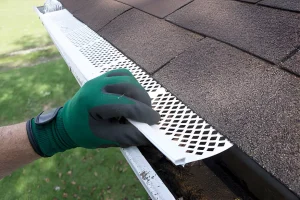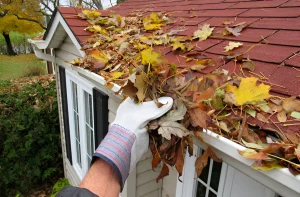If you’re looking for more advanced and unique solutions to prevent ice dams, you can explore the following options:
What is the best roof material to prevent ice dams?
- Heated Roof Systems: Install a heated roof system that uses heating cables or panels to melt snow and ice along the eaves and gutters. These systems are activated automatically or manually and can help prevent ice dam formation.
- Solar Panels with Snow-Melting Functionality: Consider solar panels with integrated snow-melting features. These panels can generate heat to melt snow and ice on the roof’s surface, reducing the risk of ice dams.
- Cool Roofs: Cool roofing materials, such as white or reflective roofing membranes, can help maintain a more consistent roof temperature by reflecting sunlight and reducing heat absorption. This can prevent uneven snow melting and ice dam formation.
- Advanced Insulation: Invest in advanced insulation materials with high R-values and airtight sealing. Spray foam insulation, for example, provides superior thermal performance and can help maintain a more even roof temperature.
- Roof Design Modifications: In some cases, modifying the roof’s design can be an effective solution. Adding a higher-pitched roof, creating a cold roof assembly, or installing a butterfly roof can all help mitigate ice dam issues.
- Electronic Roof Monitoring: Implement an electronic roof monitoring system that continuously tracks the roof’s temperature and moisture levels. This system can automatically activate heating elements or ventilation when conditions conducive to ice dam formation are detected.
- Green Roof or Vegetative Roof: Consider a green roof with live vegetation, which can insulate the roof and help regulate temperature. While not a traditional solution, it can contribute to a more even temperature on the roof surface.
- Thermal Imaging and Infrared Inspections: Conduct regular thermal imaging or infrared inspections of your roof to identify areas prone to heat loss and potential ice dam formation. This can help you address issues proactively.
- Custom Gutter and Downspout Systems: Install custom-designed gutter and downspout systems that minimize the risk of ice dam formation. Features such as heated gutters or downspouts with built-in de-icing capabilities can be effective.
- Consultation with an Architect or Engineer: If you’re dealing with a complex roofing situation or have unique requirements, consider consulting with an architect or structural engineer with expertise in roofing and ice dam prevention. They can design a tailored solution for your specific needs.
Remember that the effectiveness of these advanced and unique solutions may vary depending on your location, budget, and the unique characteristics of your home. Consulting with professionals who specialize in roofing and ice dam prevention is essential to ensure that your chosen solution is appropriate and effective for your situation.
How do you stop ice dams on a roof?
Ice dams can be a significant problem during the winter months, especially in regions with cold climates. They form when heat from the inside of a home escapes through the roof, causing the snow on the roof to melt and then refreeze at the eaves or gutters, where it’s colder. This refrozen water creates a dam that can trap additional melting snow and lead to water leaks into the home. Here are some steps to help prevent ice dams and address them if they occur:
1. Insulate your attic: Proper insulation in the attic can help prevent heat from escaping through the roof and melting snow. Make sure your attic is well-insulated and properly ventilated to maintain a consistent temperature.
2. Seal air leaks: Check for any gaps or cracks in your attic or roof where warm air could escape. Seal these areas with caulk or insulation to prevent heat loss.
3. Keep the roof cold: A cold roof means the snow will not melt and refreeze. You can achieve this by ensuring your attic is properly insulated and ventilated, as mentioned earlier. You can also add roof and soffit vents to promote airflow.
4. Remove snow: After a heavy snowfall, use a roof rake to carefully remove excess snow from your roof. Be cautious not to damage the shingles while doing so.
5. Install heated cables: Electric heated cables can be installed on the roof and gutters to melt ice and prevent dams from forming. However, they should be used as a last resort and not as the primary solution.
6. Consult a professional: If ice dams are a recurring problem or if you are not comfortable addressing them yourself, it’s a good idea to consult a professional roofer or insulation expert. They can assess your specific situation and recommend the best course of action, which may include improving insulation, ventilation, or making other structural changes to your roof.
7. Manage attic temperature: Keep your attic cool during the winter by sealing off any heat sources, such as recessed lights or HVAC ducts. This can help prevent snow from melting and refreezing on your roof.
8. Remove icicles: Icicles can contribute to ice dam formation. Safely remove them using a roof rake or by breaking them off with a long-handled tool. Be cautious when doing this to avoid injury.
Preventing ice dams is essential to protect your home from potential water damage. Taking these measures can help reduce the risk of ice dam formation, but it’s important to address the issue promptly if it occurs to prevent any damage to your roof or interior spaces.
What is the material of ice dam roof?
An ice dam roof is not constructed from a specific material. Instead, an ice dam is a ridge of ice that forms along the lower edge of a roof, typically at the eaves, and can cause water from melting snow to back up and potentially leak into the building. Ice dams can form on roofs made from various materials, including:
- Asphalt Shingles: Asphalt shingle roofs are common in many residential buildings, and ice dams can form on them if certain conditions are met.
- Metal Roofs: Metal roofs, including steel or aluminum, are also susceptible to ice dams if the right conditions exist.
- Wood Shakes or Shingles: Homes with wood shake or shingle roofs can experience ice dams as well.
- Slate or Tile Roofs: Even more durable roofing materials like slate or tile can develop ice dams under specific circumstances.
The formation of ice dams primarily depends on weather conditions and insulation and ventilation in the attic space. Proper insulation and ventilation can help prevent the conditions that lead to ice dam formation by keeping the roof surface closer to the outside temperature and preventing the melting and refreezing of snow and ice at the roof’s edge. There are also specialized ice and water shield membranes that can be installed under the roofing material to provide an additional layer of protection against ice dam-related leaks.






